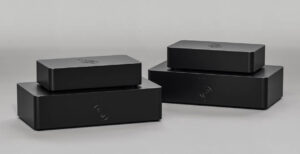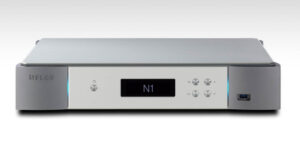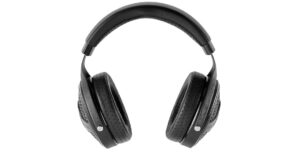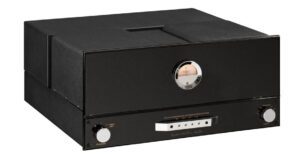
Some audio equipment functions absolutely perfectly, sounds amazing, and represents excellent value for money – which makes reviewing it pretty straightforward. Some audio equipment functions only spasmodically, sounds rough, and represents questionable value for money – and so it too is pretty straightforward to review.
Most audio equipment, though, is less cut-and-dried. Most audio equipment works pretty well, has both merits and shortcomings to the sound it makes, and consequently represents debatable value for money. So, reviewing it is not quite so straightforward.
Which leads us, not especially coincidentally, to the Arcam SA30 network streaming system.
Without a doubt, a product like the SA30 is exactly the sort of thing Arcam should be turning its hand to. Fundamentally, it consists of 120 watts (into 8 ohms, 220w in 4 ohms) of Class G amplification, a fistful of analogue and digital inputs (running from both moving magnet and moving coil phono stages to an enhanced Audio Return Channel HDMI socket), plenty of wireless connectivity and a very agreeable Sabre ESS9038K2M 32bit DAC.

This is amplifier topography Arcam has been refining for over a decade now, and for further sonic assistance the SA30 comes complete with support for Dirac Research’s ‘Live 3’ room correction software (plus a mic with which to get the full benefit). It’s possible to load up to three distinct Dirac profiles into the Arcam (because you’ve used the mic and software to measure your room for all occupancy eventualities, obviously) so the SA30 should always sound its best.
The SA30 is housed in a (robust, impeccably finished) box from Arcam’s HDA design vocabulary, and in most ways that’s a good thing. It’s of classic kit-rack proportions, feels just as expensive as it looks, and the physical controls behave nice and positively in their action.
The display, though, is as ‘classic’ as the styling. If you’re wirelessly streaming to the SA30 (and your options here are numerous, from Apple AirPlay 2 and Chromecast to Roon and UPnP) then your source device will have a nice, colourful, informative display with album art and what-have-you all available. And if you’re using an analogue source, then you’re not expecting much in the way of related information anyway. But Arcam’s dot-matrix white-on-black display, with its single-line, slowly scrolling text, looks like a throwback to the early days of MiniDisc. Compared to, say, Naim’s identically priced and quite similarly specified Uniti Atom – which is all crisp OLED screen and bright, well-rendered album artwork – the SA30 is a bit basic.
When not using a digital source to operate the Arcam, control is via a fairly standard learning handset. It works perfectly well almost all the time – although be aware that as its batteries fade, it has a period of intermittent operation rather than it simply stopping working. The key indicator here is the backlit buttons; if the backlighting powers off immediately after a button press, change the batteries fast. Control can also be achieved via Arcam’s MusicLife control app, which is nominally for iOS and Android. At the time of writing, however, the Android version of the app is still in beta testing.
There’s no such grumbling about the expansive nature of the system the SA30 can support, though – and so for testing purposes the Arcam played host to a Clearaudio Concept turntable (connected to the moving magnet phono input via its hard-wired phono cables), a Cyrus CD t disc transport (via QED Performance digital optical cable), a MacBook Air (running Roon), an Apple iPod Touch 7 packing version 13.5.1 software (for use with the MusicLife app and AirPlay 2) and a Sony Xperia 5 smartphone running Android v10 (for use with Chromecast). At the front end were a pair of Acoustic Energy AE1 Reference Series mkIII speakers on Atacama Moseco 6 stands, connected via Chord Company Rumour X speaker cable.
Dirac’s Live 3 software is thorough, and it doesn’t take all that long to supply the software with the measurements it needs to optimise the Arcam to the room it lives in and the speakers it’s buddying up to. Having designed a bespoke response curve, it’s out with the vinyl and on with an LP.
Anna Meredith’s Fibs [Moshi Moshi] is a singular recording – the composer’s concept of ‘orchestral bangers’ is realised by a band comprising drums and percussion, cello, tuba, guitar, clarinet and ‘electronics’. In the Arcam’s hands it’s a burly, large-scale listen with smoothly described dynamic peaks and troughs. When the going gets tender there’s more than enough deftness and nuance to the SA30’s presentation to describe just how delicately the instruments are being brushed or strummed, and when the band has a charge at one of Meredith’s giddily ascending, straight-edged progressions there’s more than enough power on tap for the recording to become genuinely oppressive. Low frequency impact and regulation is one of her basic building blocks, and the SA30 organises the bottom end confidently. Thanks Dirac!
It’s a big, open soundstage the Arcam establishes, and no matter if it’s Anna Meredith’s eccentric five-piece or The Band’s rather more conventional line-up on The Night They Drove Old Dixie Down [Capitol] as a 24bit/192kHz digital file delivered via Roon, the SA30 is muscularly disciplined in its presentation. Separation and focus both impress, and the ease with which individual elements of a recording can be followed is far from typical in products of this type and price. The Arcam makes some pertinent observations about the string gauge of the acoustic guitar, the tension of the skin of the snare drum, the almost supernatural sympathy of the vocal harmonies… As far as clarity, fine detail retrieval and the fundamental timbre of instruments are concerned, the SA30 is a thrillingly direct and communicative device.

Streaming an MQA file of Nick Drake’s Bryter Layter [Island] via the Roon app, a 16bit/44.1kHz file of Bobby Hughes Experience’s Fusa Riot [Ultimate Dilemma] via AirPlay 2, a CD of Pharoah Sanders’ Thembi [Impulse!] or even a relatively poverty-stricken 320kbps Spotify-derived file of Marika Hackman’s Bath is Black [Transgressive] using Chromecast doesn’t really affect the Arcam’s basic virtues. It dishes the midrange details with particular relish, it sounds big and well organised, and its tonal balance errs pleasantly on the side of the natural and organic. It’s dynamic, but never at the expense of insight; it’s expansive, but never sounds disjointed.
About the only area of playback where the Arcam doesn’t seem almost effortlessly in charge is rhythm management. The Bobby Hughes Experience album reveals hints of the SA30’s rather strait-laced approach to a recording’s flow, and the more the music edges towards the dancefloor the more the Arcam seems to be creeping out of its comfort zone. Oh, it’s not a wallflower in the manner of, say, NAD’s M10 Master Series streamer, but neither is it the most adept rug-cutter you ever heard. There’s something in the SA30’s overall attitude that’s about control and organisation, and the looseness that the most rhythm-dependant music thrives on (Fela Ransome Kuti and Africa 70’s Expensive Shit [Sounds Workshop], for instance) is in relatively short supply here.
In truth, though, when stacked against all the Arcam’s many audio virtues, this could be just as easily described as ‘trait’ rather than as a ‘shortcoming’. It makes the SA30 fractionally less compelling than it otherwise would be – but in sonic and connectivity terms, it nevertheless makes an impressively strong and complete case for itself when judged against the likes of the NAD M10 or Naim Uniti Atom.

Arcam carries a heavy burden in the time of streaming. It has to appeal to its extremely traditional core audience while having to move its products forward. That’s an almost impossible balancing act (in many ways: the use of a basic display, vs. the hi-tech benefits of Dirac, for example), but one at which Arcam performs well. While such a balancing act could conceivably take the gloss off the Arcam SA30 experience – there’s plenty of gloss on it in the first place.
TECHNICAL SPECIFICATIONS
- Amplifier section
- Type: Class G
- Analogue inputs: One MM phono input (via RCA jacks), one MC phono input (via RCA jacks), four line-level inputs (three via RCA jacks, one via 3.5mm input)
- Digital inputs: Four S/PDIF (two coaxial, two optical), one USB Type A port, one ARC/eARC HDMI input, one Ethernet port
- Analogue outputs: One pre-out (via RCA jacks), RS232 power control
- Supported sample rates: up to 32bit/192kHz
- Output impedance (preamp): 240Ohms
- Headphone Loads: 16Ohms–2kOhms
- Power Output: 120WPC @ 8 Ohms
- Bandwidth: 20Hz–20kHz
- Harmonic distortion (80% power, 8Ohms @ 1kHz): 0.002%
- Signal to Noise Ratio: Not specified
- Phono stage(s)
- Phono inputs: two pair single-ended (MM and MC, via RCA jacks)
- DAC
- Type: ESS9038K2M
- Digital inputs: two coaxial, two optical toslink, one USB Type A, one ARC/eARC HDMI
- DAC resolution: 32bit/192kHz
- Supported sample rates (kHz) (coaxial): 32, 44.1, 48, 88.2, 96
- Supported sample rates (kHz) (optical): 32, 44.1, 48, 88.2, 96, 176.4, 192
- Frequency response: 20Hz–20kHz +/- 0.1dB
- Distortion (THD + Noise): 0.0007%
- Dimensions (H×W×D): 100 × 433 × 323mm
- Weight: 10.7kg
- Price: £1,995
Manufacturer: Arcam
URL: arcam.co.uk
Tel: +44(0)1220 203200
Tags: FEATURED
By Simon Lucas
More articles from this authorRead Next From Review
See all
Reiki Audio SuperSwitch Master Pro + Servant Pro
- Mar 27, 2024

Melco Audio N1-S38 music server
- Mar 27, 2024

Focal Utopia 2022 headphones
- Mar 27, 2024











